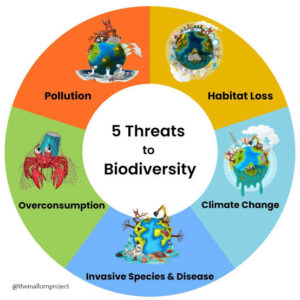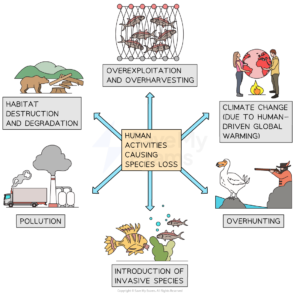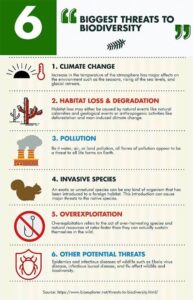Back to: Botany 300 Level
Hello, my brilliant Afrilearn scholar! I hope you’re doing great today! Have you ever noticed how forests and green spaces are disappearing in many parts of Nigeria? Have you heard about plants that don’t belong in an area suddenly taking over and pushing out native species? These are just some of the threats to plant biodiversity, and they have serious consequences for our environment. Today, we’ll talk about the major threats to plant biodiversity, why they matter, and what we can do to protect our natural world.
Threats to plant biodiversity (deforestation, invasive species, habitat fragmentation)
What is Plant Biodiversity, and Why Is It Important?
Plant biodiversity refers to the variety of plant species found in different ecosystems. Plants are the foundation of life on Earth—they provide oxygen, food, medicine, and habitat for animals. When plant biodiversity is threatened, it affects the entire ecosystem, including humans.
Unfortunately, several human activities and environmental changes are causing plant species to disappear at an alarming rate. Let’s look at the major threats.
1. Deforestation: The Silent Killer of Forests
Deforestation is the large-scale clearing of forests for farming, urbanisation, and logging. When trees are cut down faster than they can grow back, plant biodiversity suffers.

Causes of Deforestation
Agriculture: Large forests are cleared to make way for farms and plantations (e.g., oil palm and cocoa farms in Nigeria).
Logging: Trees are cut down for timber and firewood, reducing forest cover.
Urban Development: Expanding cities and roads destroy natural habitats.
Mining: Mining for gold, oil, and other minerals leads to land degradation and forest loss.
Effects of Deforestation
Loss of plant species – Unique plants, especially those used in medicine, can go extinct.
Climate change – Trees absorb carbon dioxide, so cutting them down increases global warming.
Soil erosion – Without tree roots to hold the soil, erosion and desertification occur.
Loss of animal habitats – Animals that depend on trees for food and shelter are displaced.
Example in Nigeria: The destruction of the Cross River rainforest has endangered plants and animals, including the Ekoi tree and the Cross River gorilla.
What Can Be Done?
Practising afforestation (planting trees) and reforestation (restoring lost forests).
Supporting sustainable logging and using alternative energy sources instead of firewood.

Encouraging agroforestry—planting trees alongside crops to maintain biodiversity.
2. Invasive Species: Unwanted Guests That Take Over
Invasive species are non-native plants that spread rapidly and outcompete native plants. These species often have no natural predators, allowing them to take over entire ecosystems.
How Do Invasive Species Spread?
Human activities – People introduce foreign plants intentionally (for decoration or farming) or accidentally (through trade and transport).
Climate change – Warmer temperatures can help invasive species thrive in new areas.
Lack of predators – Since invasive plants don’t have natural enemies in their new environment, they grow unchecked.
Effects of Invasive Species
They outcompete native plants – Invasive plants grow faster and take up space, light, and nutrients.
Loss of biodiversity – Native plant species die out, leading to a less diverse ecosystem.
Economic damage – Farmers lose crops when invasive plants spread into farmlands.
Example in Nigeria: The water hyacinth (Eichhornia crassipes), introduced from South America, has spread uncontrollably in rivers like the Niger River, blocking waterways and harming aquatic life.
What Can Be Done?
Controlling invasive plants by removing them from affected areas.
Raising awareness about the dangers of introducing foreign plants.
Using biological control—introducing natural predators to keep invasive species in check.
3. Habitat Fragmentation: Breaking Nature into Pieces
Habitat fragmentation happens when large, continuous habitats (like forests, grasslands, or wetlands) are broken into smaller patches due to human activities.
Causes of Habitat Fragmentation
Road construction – Roads cut through forests, dividing them into smaller sections.
Farming and settlements – As people expand farmland and build houses, natural habitats shrink.
Dams and infrastructure projects – These create barriers that separate plant populations.

Effects of Habitat Fragmentation
Isolated plant populations – When plant species are separated, they have fewer chances to reproduce, leading to a decline in their population.
Loss of pollinators – Bees, birds, and butterflies that help in pollination may be unable to move between plant populations.
Weaker ecosystems – Fragmented habitats are more vulnerable to extreme weather and climate change.
Example in Nigeria: The Okomu National Park is one of the last protected rainforests in Nigeria, but roads and farms have reduced its size, putting rare plant species at risk.
What Can Be Done?
Creating wildlife corridors—planting trees between fragmented areas to connect plant populations.
Protecting and expanding national parks and reserves.
Using land wisely—balancing development with conservation efforts.
Other Threats to Plant Biodiversity
Apart from the three major threats above, plant biodiversity is also threatened by:
Climate Change – Rising temperatures, unpredictable rainfall, and extreme weather conditions make it harder for plants to survive.
Pollution – Industrial waste, oil spills, and chemical fertilisers degrade the soil and kill plant life.
Overharvesting – Excessive collection of medicinal plants and timber can wipe out plant populations.
Summary
Plant biodiversity is under threat due to human activities and environmental changes. The major threats include deforestation, which destroys forests and reduces plant populations; invasive species, which take over and outcompete native plants; and habitat fragmentation, which isolates plant populations and weakens ecosystems. Other threats include climate change, pollution, and overharvesting.
Protecting plant biodiversity is essential for food security, medicine, climate regulation, and ecosystem balance. By planting trees, preventing the spread of invasive species, and protecting natural habitats, we can help preserve plant life for future generations.
Evaluation
- What is plant biodiversity, and why is it important?
- List three causes of deforestation and their effects on plant biodiversity.
- How do invasive species affect native plant populations?
- What is habitat fragmentation, and how does it threaten plant biodiversity?
- Mention two ways we can protect plant biodiversity in Nigeria.
You’re doing amazing! Now you understand how plants are being threatened and what we can do to help. Keep learning, keep asking questions, and most importantly, keep caring for the environment. See you in the next exciting Afrilearn lesson!
